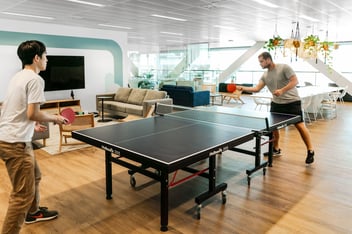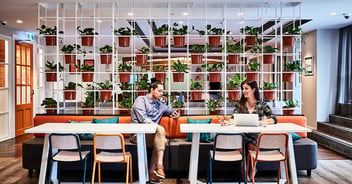Workplace wellness and wellbeing isn’t a new trend. The wellbeing of employees is a topic that has been on the rise for years, but has seen unprecedented acceleration due to the COVID-19 pandemic. In fact, we recently held a Future of Work webinar where 84 percent of the audience said their company workplace wellness approach had positively changed since the events of last year.
So what do these changes look like in the new hybrid workplace and how will workplace wellbeing shape the future of work? Let’s explore.
The hybrid workplace
McCrindle research has found that 61 percent of Australians want flexibility in their work arrangements, with a combination of working from home and working from the office – meaning the workplace’s future will be a hybrid model.
This change is supported from the top, with CEOs of some of Australia’s most successful companies shifting to a hybrid way of working, including Mirvac, Telstra and NAB. Even the government is on board: the Queensland Government told it’s employees it expects many workers to fall under a hybrid work model.
At Axiom, we agree that the office will look different. Rather than having a majority of people in the office working from a desk, we will see more breakout spaces, team spaces and collaboration hubs – workspaces where people can safely gather to exchange knowledge and ideas. While this hybrid model of work was already on the horizon, the pandemic has undoubtedly accelerated the timeline.
A look into the future
During our Future of Work webinar, the panel discussed the trends they are noticing in workplace wellness and wellbeing now and into the coming years.
First, let us introduce the speakers:
- Jack Noonan – Vice President, Asia Pacific, International WELL Building Institute
- Eminè Mehmet – CEO, WELL Space
- Josh Lambert – Founder, Well Workplaces
- And our moderator: Annelie Xenofontos – Senior Workplace Strategist, Axiom Workplaces
The financial impact of wellbeing
Although workplace wellbeing programs aren’t new, the COVID-19 era has ushered in a new awareness of how employees’ health and wellbeing has a material effect on a company’s bottom line.
“It hasn’t been appreciated until now, but a healthy and well workforce creates a healthy and well organisation,” said Jack Noonan.
Making the invisible visible
The past year has been about “making the invisible visible”, explained Jack. Whether that’s the COVID-19 virus no one can see or instilling confidence in a workforce to return to the office, the focus has been on making those invisible things tangible and actionable. Jack also pointed out that sensor technology is trending for validation and verification of things like air and water quality – all circling back to building employee confidence in their health and wellbeing at work by making the invisible visible.
Focus on health equity
While pre-COVID workplace wellness programs existed, the percentage of people who opted in was low at 20-40 percent, said Jack. And most of the time, those people were the ones who needed that intervention the least. This was a concern then, but the concept of ‘health equity’ has been fast-tracked post-COVID.
What is health equity? The World Health Organisation defines it as “the absence of unfair and avoidable or remediable differences in health among population groups defined socially, economically, demographically or geographically”. In the workplace, this means that workplace wellness needs to be for all people – not just those who opt-in. In practice, this means putting health and wellness into leadership and policy.
As Josh Lambert said, “wellbeing needs to have equity of access for all” – it’s now a necessity and “there is a duty of care on employers to provide a well workplace”.
Preventative action
“The reality is that 98 percent of health spending in Australia is on treatment. Less than 1.5 percent goes to prevention. Yet 35 percent of chronic diseases in Australia are preventable,” said Jack.
He pointed out a huge opportunity here for workplaces to help prevent illness with proactive wellbeing programs and initiatives.
A culture of health
People are actively looking for ways to improve their health, according to Eminè Mehmet. Since the pandemic outbreak, she explained, the population has become more knowledgeable on what needs to be increased and enhanced at work for their health.
Josh noted that we see this demonstrated in the workplace with the rise of the Chief Wellness Officer (CWO). “Employees are driving change with their demand,” he said.
This shift in narrative drives a ‘culture of health’, where old ways of working are broken down with a more coordinated and collaborative approach to health across organisations. Jack illustrated this point by describing the surge in meetings between the heads of facilities and the heads of HR.
Your top 5 workplace wellness goals
The Future of Work webinar wrapped up with our panel describing the high-value areas to spend your energy and budget on:
1) Building wellbeing into strategy
Wellbeing needs to be more than just values pinned on the wall, explained Josh. It needs to sit within the overall business strategy and be supported by a health and wellbeing culture.
2) Promotion and branding of wellbeing initiatives
“There is no point having a program on paper if it’s not promoted and branded internally,” said Josh.
“Give the program a persona or brand to create awareness. The initiative will only be as good as the awareness of it.”
3) Air quality
Unsurprisingly, Eminè recommended we turn our focus to the air quality in our workspaces. In fact, the adoption of technology that measures air quality is increasing, including airborne particle monitoring.
4) Engagement with employees
In order to create something significant in the wellbeing space, you must engage with your employees to find out what they need. Eminè noted that any wellbeing initiative “needs to be specific to your people for it to be used”. She explained that a company culture of openness and willingness to listen is needed for any engagement to be successful, otherwise people will not speak up.
5) Monitoring and measurement
Fifty-seven percent of our webinar audience said their organisation doesn’t currently measure how their physical workplace supports people, productivity and culture. Yet, as Jack explained, “You can’t manage what you don’t measure. Small or big.”
Annelie Xenofontos added, “You have to hit the handbrake. Go back to what the objective is, then engage in the design to create the right space.”
Want to explore more about what the future of work might look like in your workplace? Examine the four fundamental elements of the future of work – people, process, place and tools – in the Future of Work: A Progressive Leaders Guide To Staying Ahead.






